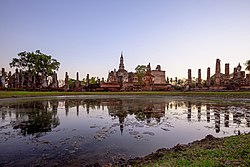This article needs additional citations for verification .(January 2019) |
Central Region ภาคกลาง | |
|---|---|
From upper-left to lower-right: Lumphini Park; Wat Chaiwatthanaram; Fishing, Bueng Boraphet; Wat Mahathat Sukhothai Historical Park; Khao Kho National Park | |
 Central Region in Thailand | |
| Largest city | Bangkok |
| Provinces | 21 Provinces 1 Special administrative area
|
| Area | |
• Total | 91,798.64 km2 (35,443.65 sq mi) |
| Population (2015) | |
• Total | 20,183,134 |
| • Density | 220/km2 (570/sq mi) |
| GDP | |
| • Total | US$286.7 billion (2019) |
| Time zone | UTC+07:00 (ICT) |
| Language | Thai • others |
Central Thailand (Central Plain) (historically also known as Siam or Dvaravati ) is one of the regions of Thailand, covering the broad alluvial plain of the Chao Phraya River. It is separated from northeast Thailand (Isan) by the Phetchabun mountain range. The Tenasserim Hills separate it from Myanmar to the west. In the north it is bounded by the Phi Pan Nam Range, one of the hilly systems of northern Thailand. The area was the heartland of the Ayutthaya Kingdom (at times referred to as Siam) and is still the dominant area of Thailand since it contains the world's most primate city, Bangkok.







